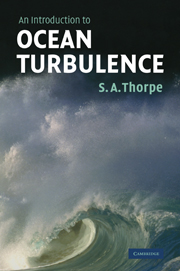Book contents
- Frontmatter
- Contents
- Preface
- Notes on the text
- Acknowledgements
- Abbreviations
- Standard parameters and symbols
- Units and their symbols
- SI prefixes
- Approximate values of commonly used measures
- 1 Turbulence, heat and waves
- 2 Measurement of ocean turbulence
- 3 Turbulence in oceanic boundary layers
- 4 Turbulence in the ocean pycnocline
- 5 Turbulent dispersion
- 6 The energetics of ocean mixing
- References
- Index
- Answers
4 - Turbulence in the ocean pycnocline
Published online by Cambridge University Press: 05 June 2012
- Frontmatter
- Contents
- Preface
- Notes on the text
- Acknowledgements
- Abbreviations
- Standard parameters and symbols
- Units and their symbols
- SI prefixes
- Approximate values of commonly used measures
- 1 Turbulence, heat and waves
- 2 Measurement of ocean turbulence
- 3 Turbulence in oceanic boundary layers
- 4 Turbulence in the ocean pycnocline
- 5 Turbulent dispersion
- 6 The energetics of ocean mixing
- References
- Index
- Answers
Summary
Introduction
Processes of turbulence generation
This chapter is about turbulence within the stratified body of the ocean beyond the direct effects, described in Chapter 3, of its boundaries. The ultimate sources of energy leading to mixing in the ocean are external. The processes causing mixing in the stratified regions of the ocean derive their energy internally, as illustrated in Fig. 3.2, from sources (e.g., radiating internal waves) that may themselves be directly or indirectly driven by external forcing at the boundaries.
Two very different processes usually dominate in the generation of turbulence and diapycnal mixing in the stably stratified ocean. The first is instability resulting from the shear or differential motion of water, i.e., the vertical gradient of the horizontal current, dU/dz, which is often caused by internal waves. This is described in Section 4.2 and some aspects and evidence of the related turbulent motion are presented in Sections 4.3–4.7. The second process is more subtle, a form of convection that results from the different molecular diffusion coefficients of heat and salinity. How these lead to instability is explained in Section 4.8.
The first observations of turbulence in the thermocline
The first published measurements of turbulence within the stratified waters of the thermocline were reported in 1968 by Grant, Moilliet and Vogel. They were made off the west coast of Vancouver Island using hot-film anemometers mounted on a submarine. Grant and his colleagues compared their measurements of turbulence with those made in the mixed layer near the sea surface.
- Type
- Chapter
- Information
- An Introduction to Ocean Turbulence , pp. 116 - 157Publisher: Cambridge University PressPrint publication year: 2007
- 1
- Cited by



